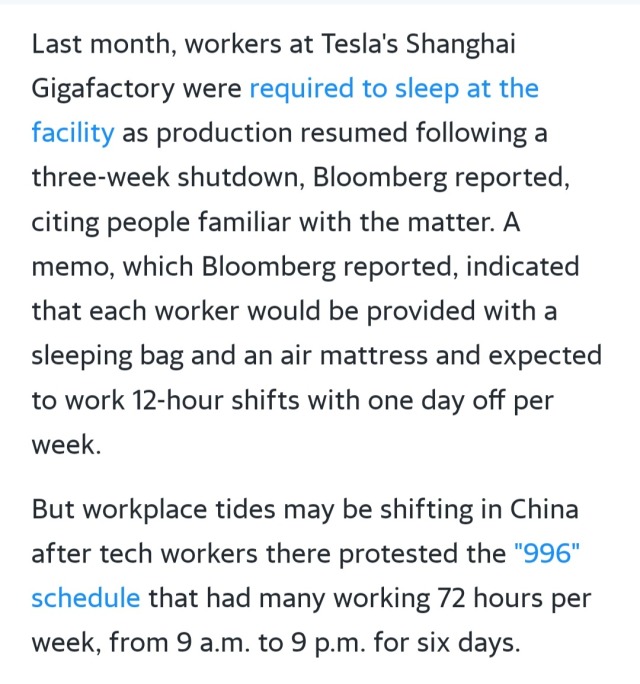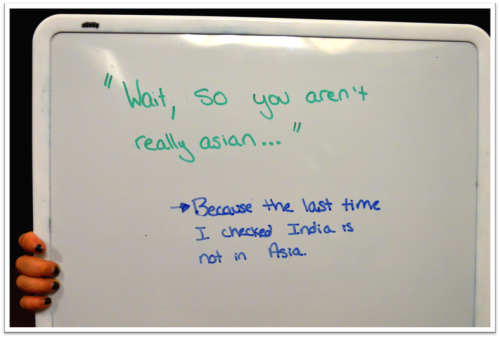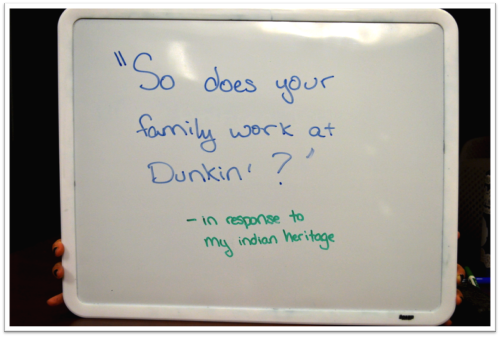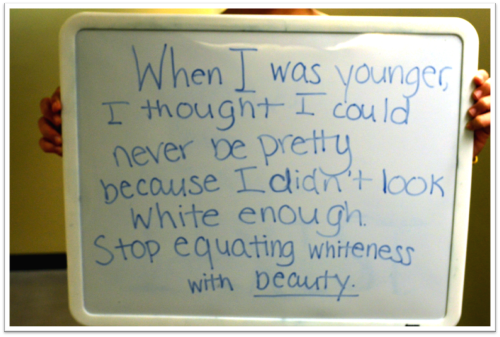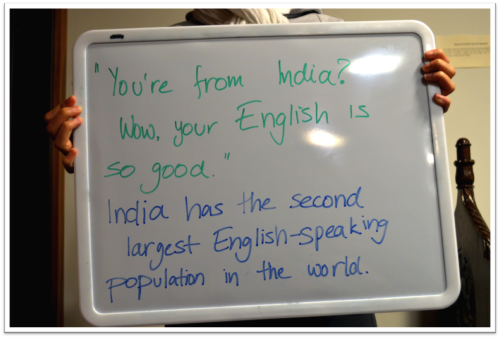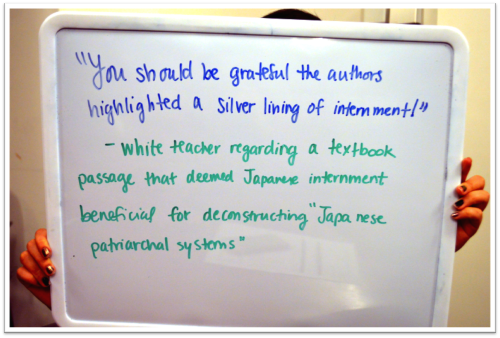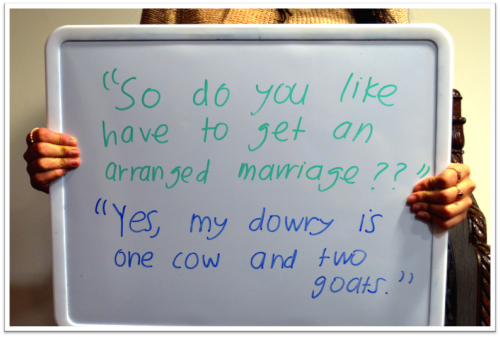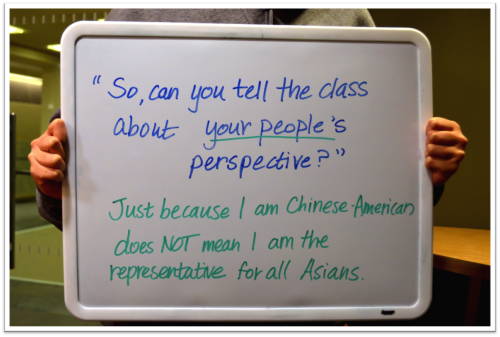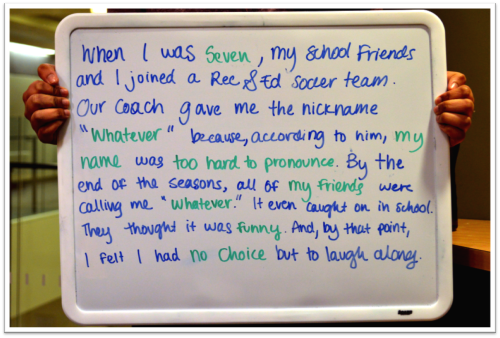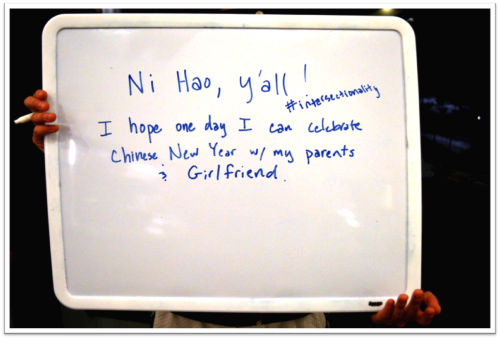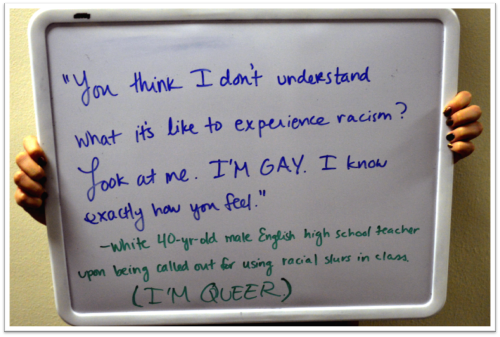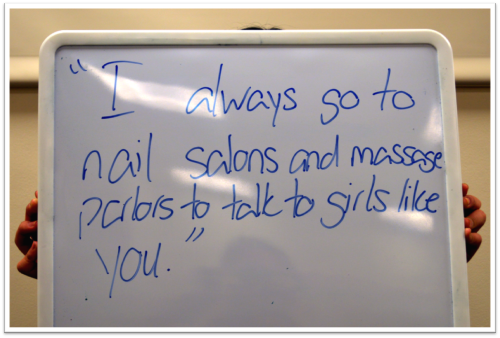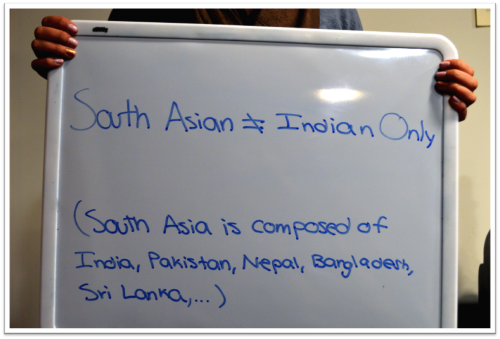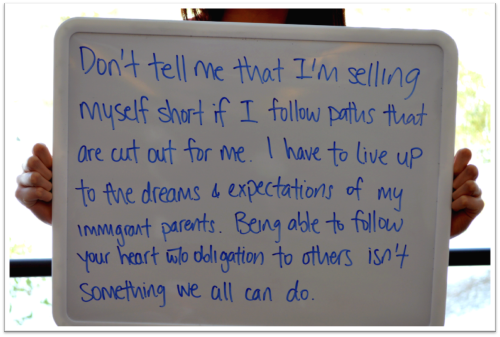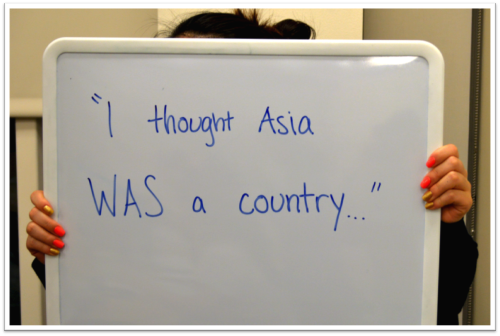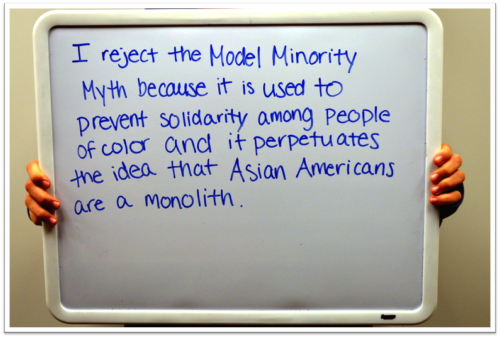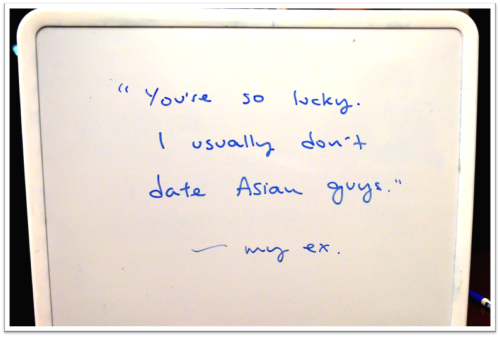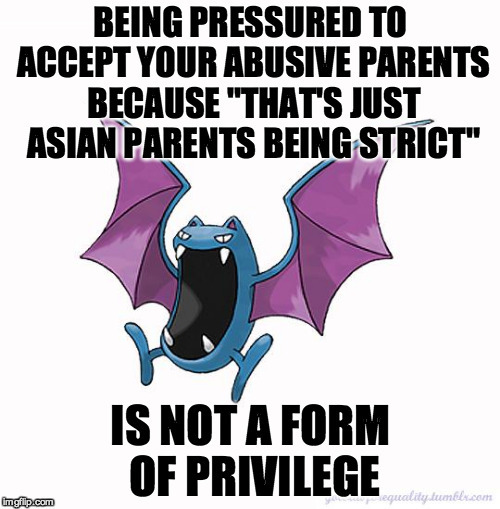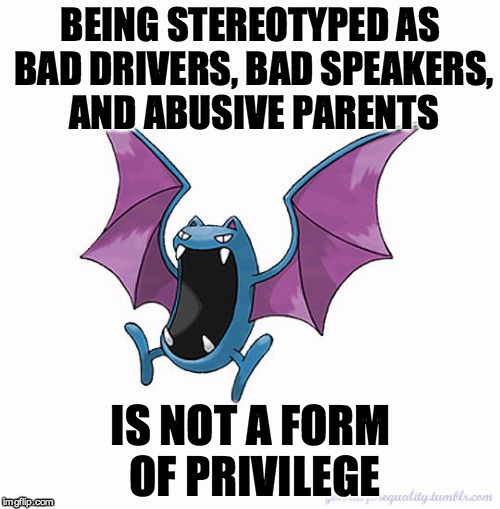#model minority
I just got the news that a newlywed couple in our community were the target of hate crime. The guy has a broke nose, among other injuries, and the wife is in the ER and needed to get stitches on all of her face. They were merely were out to walk around the neighborhood and this happened to them within the comfort of their neighborhood.
These sort of hate crimes happen all the time, not too long ago, and old man was selling shoes/other little things in front of his house and was beaten up by 3-4 young men. In front of his house. On his porch.
I want to stress that these both cases (among others) weren’t carried out anyone other than the precious ~PoCs~. This is exactly what I mean when I talk about hierarchies, because in people’s little perfect theoretical worlds, everything is created into simple categories, where the Pakistanis/Asians have privilege and can’t be target of hate crime/racism when carried out by Black or Latin@ people because of the apparent political power we hold.
These hierarchies are created by White supremacist thought, and as long as we don’t move away from them, and go on about false sense of power dynamics (in which everything is depicted as one sided) we will not get to the root of the problem.
When people speak on Asian or Pakistani privilege they are completely removed from the reality we live in, and want a simple cookie-cutter theory when in fact reality is much more complicated than that.
I know this is supposed to be “controversial” because I’m going against whatever is held to be the truth on here, that Pakistanis/Asians hold certain power over Latin@ or Black communities and that whatever crime done against us, the constant spying, living under the security/surveillance apparatus is a mere form of “prejudice” without any sort of power behind it, the anti-islamic and anti-pakistani hate crimes exist in some sort of tight limited space of “privilege” but that’s not the reality many of us live in and I would rather not follow some removed-from-reality theory for others convenience.
Of course, I shouldn’t have to stress this as it’s obvious, that I don’t mean if X doesn’t have power than Y obviously does. But this is to complicate the simplistic approach to race most people have where the hate crimes carried out by people who fall into the PoC category get unchecked and unnoticed. White crimes on PoC exists in various forms, but that’s not the start and end of the conversation and racial dynamic.
Simply put, these hierarchic sand faux “privilege” politics distort reality.
For all the hype about Asian American success and Asian Americans as the model minority, the reality is much more complicated. Even though the stereotype is that Asians are “smarter” and more “academically-driven” than non-Hispanic whites (honestly, this distinction is really insensitive, and I just want to say that), in reality, Asians are actually more likely to get a bachelor’s degree, but less likely to have a high school degree, indicating that Asian Americans who do “succeed” academically may do so to a greater degree than their “white” peers, but that those who do not achieve academic success are worse off than their white peers.
As a whole, they still seem “better off” than other minorities. There is a marked difference when we break down the statistics by country of origin, however.
Most of these differences are very clear when we consider history – returning to the(condensed and incomplete) timelines from my second post, that America signed immigration treaties with these different nations at different times under different circumstances. Yet in the simplification of the term “Asian American,” most people really only notice the most prominent countries:

Ignorance of the “lesser” populations, the smaller ones, hides a lot of startling differences in the narratives we see. Furthermore, a substantial percentage of immigration comes from those seeking refuge, and I have had friends whose families were torn apart in the hope that one or two might receive a better fate. A friend of mine from high school never saw her parents and two older sisters after a decision for her to come to America with an aunt, yet the hope is that a reunion may come someday. For those who come without fortune, connections, any understanding of the language, ready employment, for those who have lost their family, home, and often, all that they own, America can be a very different place.
Even within a single country of origin though, there are still many wide achievement gaps, depending on what generation “American” you are, as well as the time period of your immigration. I speak from the Chinese background, which I have seen the most of.
The first immigrants that gain a lot of public attention are the cheap migrant workers, such us those on the Continental Railroad. Much like the early Irish immigrants or our contemporary Mexican immigrants, they had poor education, but had come to seek a better living and to provide for their families.
The next wave of immigrants from mainland China were not until much later. Even with the Immigration Law, the People’s Republic of China placed strict restrictions on emigration until 1977, so much of the immigration in the 1960′s and 1970′s were from Taiwan. This early immigration accounts for why when Taiwanese are statistically “more prosperous” in demographic studies relative to individuals from mainland China (NOTE: if you do not know the complicated history and politics between Chinese and Taiwan, please Google it, as it is important, but not enough that I will entail it in this short blog entry.)
At the same time, the Cultural Revolution “destroyed” and “redistributed” wealth – at least in theory. There is much that could be said about the ideological shifts that happened and their impact on current history, but in the interest of time, I will simply conclude by saying that many of the immigrants which came next were generally not wealthy. Once the immigration barriers were first lifted, most of the next wave of individuals who arrived were scholars and businessmen. Many, like my parents, and the parents of a lot of my cohorts, became fairly well established by the time I was a teenager. However, there were also many undocumented immigrants, without offers at institutions of study, who forged their own way through manual labor, often in places like Chinatown. In many Chinese grocery marts, there are advertisements for English lessons, which are the rare opportunities for education and advancement that many of the “older” citizenry may have, if at all.
This contrasts heavily with the latest generation of immigrants, which contain a much larger percentage of students from wealthy backgrounds sent to America for study and stimulation. As Asia has prospered, education has become extremely competitive, with heavy fees for the best schools and extracurricular classes in every imaginable pursuit.
In short, there are very strange contrasts set-up in today’s Chinese American population, primarily in a publicly largely unrecognized class divide. There are, as I see them, three large categories which exist today:
- Chinese Americans whose parents have “pulled themselves up by their bootstraps” and made many sacrifices to ensure the access of their children to a good education
- Chinese Americans whose parents were disadvantaged, and whose children are now given the opportunity of the parents of those in group 1
- Chinese Americans currently immigrating from China from relatively successful families (this has also been aided somewhat by the one-child policy, which allows for a greater concentration of resources into single individuals*)
That is to say, there are two populations of Chinese Americans which are generally more affluent – but even that is a wide range, and the class differences that apply to other populations are just as evident in this population. Yet many of the stereotypes of Chinese American behavior, their stinginess and bargain-shopping comes from the past generation, where smart spending was a necessity of survival, a lifestyle that many families still have to live by within the Chinese American community but that for others is just a funny caricature of their parents. And to the influx of Chinese immigrants, some of these stereotypes don’t hold any cultural relevancy.
There is so much more that could be said dissecting the different cultures of these groups, where they intersect and where they don’t, but as this is already rather lengthy, I will simply conclude with this thought:
Race is NEVER a stand-in for class. The more we make generalizations by ethnic and national categories, the more we obscure the struggles of many within these populations, and hold them to expectations that are as impossible to them as someone who is a “true minority.” While national and cultural pride is something that should be honored and often becomes a key component of understanding one’s identity, while languages and traditions connect individuals of diverse backgrounds, it is also alienating for individuals whose realities are not understood or represented in the large understandings of racial demographic patterns. The statistics about Chinese American affluence do nothing to alleviate the struggles of those living in Chinatown, who are visited by the affluent, but who often live in squalor, whose stories are never told though their accents are laughed at and whose communities only come to light in reports about suspicious meats being served. American media has upheld the model minority standard while remaining suspicious of the impoverished within the community, never stopping to recognize a problem exists in their definition of the category of race.
I speak about the Chinese because they are not a minor, obscure minority that we have forgotten about. They are a large, over-generalized racial category that does not work.
*Granted, for said individuals, the financial burden is much greater on them to provide for two sets of parents by themselves, and would exponentially increase over time if everyone followed the laws properly, and life was mathematical, but given that this isn’t really relevant to the point at hand, please just store it away as a consideration for a rainy day.
Sociological Imagination is an approach to the world around us at the intersection of the world and person, history and biography, and creating an understanding such that renders one better equipped to navigate the structures around them. This is the first blog post in a series of three wherein I have elected to investigate the Asian-American identity from different perspectives. In my first blog post, I’ve approached the idea from an individual autobiographical standpoint, drawing from my personal experiences and struggles with identity. In my second blog post, I examine the idea from a historical perspective, while this, the third, draws some concluding thoughts from the intersection of history, biography, and social trends.
Graphs and diagrams taken from “Asian Americans” from Pew Social Trends, 2010-2012 and “A Community of Contrasts” released by Asian American Center for Advancing Justice about the Asian American community in 2011.
The false equivalence in Musk is so strong, as if people anywhere should be exploited way past safe, mental and physical limitations. There are reasons for limiting work and why there are regulations about age, overtime, and compensation. Technology is already a problem where work easily bleeds into uncompensated time and leave.
This isn’t complimentary to anyone’s work ethic and falls square into the model minority myth. Many of us remember the horror of hearing about people committing suicide over work conditions or overworking themselves to death at Foxconn factories, and the reaction was to install nets and hire a PR firm. Things are outsourced to China and other “developing” countries for exploitative reasons, not because people are unwilling to do them and the safeguards against reckless profiteering in one place do not extend to corporations internationally.
This is a colonialist attitude, as if Chinese and other ethnic minorities have not been historically exploited as migrant labour–underpaid, undervalued, and put in harm’s way even as citizens of industrialized nations. People still feel the need to count how many generations their families have lived and toiled because we’re constantly reminded we are seen as foreign, discriminated against, and always a hair from being blamed for our own victimization.
Elon and his ilk can take their backhanded praise and choke on it.
Wellesley Asian Alliance’s annual poster campaign is underway. Want to participate in the dialogue? Send us a message on tumblr or tweet with the hashtag #waaposter
Post link
Wellesley Asian Alliance’s annual poster campaign is underway. Want to participate in the dialogue? Send us a message on tumblr or tweet with the hashtag #waaposter
Post link
Wellesley Asian Alliance’s annual poster campaign is underway. Want to participate in the dialogue? Send us a message on tumblr or tweet with the hashtag #waaposter
Post link
Wellesley Asian Alliance’s annual poster campaign is underway. Want to participate in the dialogue? Send us a message on tumblr or tweet with the hashtag #waaposter
Post link
Wellesley Asian Alliance’s annual poster campaign is underway. Want to participate in the dialogue? Send us a message on tumblr or tweet with the hashtag #waaposter
Post link
“The privilege of asssimilation is that you are left alone. But assimilation must not be mistaken for power, because once you have acquired power, you are exposed, and your model minority qualifications that helped you in the past can be used against you, since you are no longer invisible.”
- Cathy Park Hong in Minor Feelings
Equality Golbat: “Being pressured to accept your abusive parents because ‘that’s just Asian parents being strict’ is not a form of privilege.”
Post link
Equality Golbat: “Being stereotyped as bad drivers, bad speakers, and abusive parents is not a form of privilege.”
Post link




